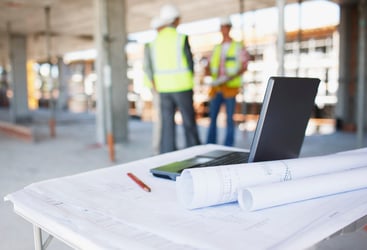Climate change is redefining expectations for design professionals. Courts now see resilience, the ability to withstand extreme weather and anticipate future risks, as basic professional responsibility. As storms intensify and climate data becomes more accessible, firms that fail to plan ahead could face lawsuits or liability for foreseeable harm.
This shift brings risk and opportunity.
Planning for resilience early can reduce legal exposure, improve project performance, and help firms stand out in a competitive market. It also signals to clients that your team can manage long-term challenges, not just meet minimum standards.
How courts are shaping A&E design liability
Courts use the “standard of care” to decide if a design firm acted responsibly. In the past, courts compared a firm’s work to what others were doing at the time. Now, as knowledge about climate risks grows, those expectations are rising.
Here are a few examples:
- In Massachusetts, a court said an American multinational oil and gas corporation should have planned for future climate risks, even if the EPA’s permit didn’t ask for it.
- In Colorado, a judge stopped a dam project because the planners didn’t model heat and drought risks, even though they knew about them. Hundreds of millions of dollars had already been invested in the project, underscoring the magnitude of the failure to plan.
- In New York, a court said a 1950s school design wasn’t at fault for asbestos use, showing that timing and available knowledge matter.
These cases show that when professionals know of climate risks, they are expected to act. As public awareness grows, courts are more likely to view a failure to act as negligence, even when older standards didn’t require it.
Why meeting building code isn’t sufficient
Building codes are based on past weather and often don’t reflect current or future risks. Just meeting code may not be enough to avoid legal issues or damages. In fact, some courts are starting to ask whether a design responded to known risks, not just if it passed inspection.
Today, clients and regulators expect design teams to:
- Use reliable tools to study risks like heat, flooding, and rising seas.
- Plan beyond the minimum when future conditions call for it.
- Keep records of important decisions, especially when clients say no to added protection.
Many cities are already moving in this direction. For example, New York, Boston, and Philadelphia have released planning guides that help address climate risks. These documents use future-focused weather models to estimate heat waves, flooding, and sea level rise throughout a building's life. They also help professionals design with those risks in mind, not just respond after the fact.
While these tools are often required for public projects, private developers can also benefit from them. They support stronger projects, lower risk, and show clients your team is ready for what’s ahead. Using these resources early also helps avoid costly redesigns later in the process.
How early site planning reduces risk and cost
Planning for resilience early in a project leads to better results. It lowers long-term costs, helps teams work more efficiently, and gives more time to design smart, site-specific solutions.
Here’s how to begin:
- Check for risks: Use free tools, such as the examples later in this article, to determine whether the site is vulnerable to future heat, flooding, wildfires, or other hazards.
- Talk with clients: Explain the difference between resilience and sustainability to guide early choices.
- Plan together: Align design, engineering, and insurance teams early to avoid changes and gaps later in the process.
Bringing everyone together during feasibility or early design stages gives the team more flexibility. They can adjust layouts, materials, building systems, and locations based on long-term risks. Waiting until construction often leads to higher costs, rushed changes, and missed chances to build smarter.
Resilient projects also make better financial sense for clients. A building designed to last through the next 50 years, not just pass today’s code, is a stronger investment and often has fewer surprises down the road.
Climate liability: Legal and insurance effects
True resilience encompasses robust design and the proactive handling of legal and insurance liabilities. As courts focus more on known risks, failing to address them can become a liability issue. This is especially important in areas prone to storms, flooding, drought, or heat.
Firms can protect themselves by:
- Adding contract language that shows clients had knowledge of future risks and chose not to act.
- Including disclaimers that refer to “extreme weather” instead of “climate change” to avoid legal debates about the cause of damage.
- Using reliable data from the National Oceanic and Atmospheric Administration (NOAA), Intergovernmental Panel on Climate Change (IPCC), and local or state climate plans to support decisions.
These steps help firms show that they act responsibly. That matters to insurance providers. Even though most liability insurance covers climate-related issues, insurance carriers are paying closer attention to how firms handle risk. Firms that take climate seriously and keep good records may get better rates, broader coverage, and stronger relationships with insurers.
Insurance policies may change to reflect climate challenges in the future. Getting ahead now makes it easier to adapt later.
6 practical steps to protect your design firm
Design professionals can take simple but effective steps to reduce risk and build stronger projects:
- Review climate risks for every project.
- Utilize free tools like:
- NOAA’s Climate Explorer
- U.S. Climate Resilience Toolkit
- IPCC regional fact sheets
- Local or state climate planning guides
- Include resilience expectations in requests for quotes, proposals, and client agreements.
- Keep clear records when clients decline resilience strategies.
- Work with legal teams to update contract language.
- Use tools like the American Institute of Architect’s new climate modeling service to see location-specific risks for flooding, heat, and wildfire.
These actions protect your projects, strengthen your contracts, and demonstrate your team’s readiness for the future. They also help clients make informed choices that lead to better long-term outcomes.
Rising expectations and a path forward
Resilience is no longer optional; courts, clients, and insurance providers are raising expectations. The good news is that there are more tools and guides than ever to help firms get this right.
Plan for future risks to reduce legal exposure, build stronger projects, and earn client trust, all while making buildings and infrastructure safer for decades to come.
The standards are changing. The risks are rising. The time to act is now.
Want to learn more?
Connect with the Risk Strategies Architects & Engineers team at aepro@risk-strategies.com.
- Adam Palant, Integrated Media Account Manager, Engineering News-Record
- Yvonne Castillo, Director of Risk Management, Victor U.S.
- Maggie Hopkins, Vice President – Climate Resilience and Adaptation, New York-based AKRF
- Chris Mundell, Architectural Project Manager, Dallas-based Parkhill
Note: Watch the webinar here to earn continuing education credits through May 2026.




